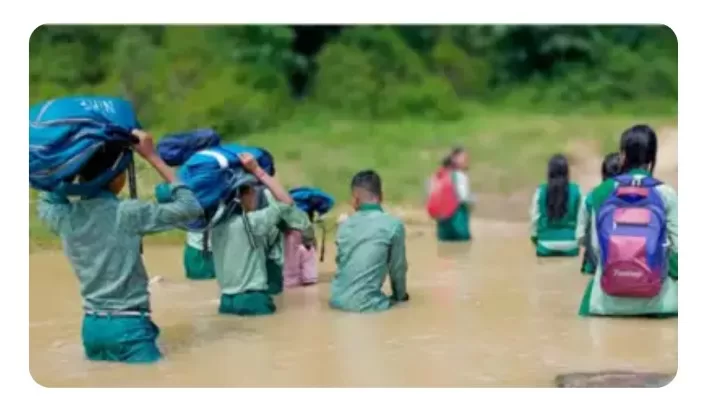For the young students of Lohra village in the heart of Jharkhand, India, embarking on their daily quest for education entails a journey akin to an arduous trial. They must traverse a river and thread through the depths of a forest to reach their school, regardless of the prevailing challenges.
Lohra, nestled in the tribal terrain of Keredari block, Hazaribagh, stands about 20 kilometers from its block headquarters. The village boasts a middle school, but for students seeking higher education, the Utkramit Uchch Vidyalaya in Hesatu, located in the neighboring Chatra district, is the sole option. The rain-fed Lohra river separates the two districts, presenting a formidable natural barrier, bereft of a bridge that could facilitate Lohra’s residents in their journey to Tandwa.
The river, swelled by the monsoon, takes on a perilous aspect. A child’s misstep on its rocky bed could result in being swept away by the unforgiving current. Yet, the students remain unwavering in their determination to attend school throughout the year.
Sachin Kumar Ganjhu, a resilient class 10 student, reflects on the predicament, remarking, “We cannot afford to stay away from our pursuit of knowledge during the monsoon months. Who else will dispel our doubts?” He further elucidates that they meticulously gauge the river’s depth using sticks before venturing into the waters. “If the water level surges,” Khushbu Kumari, a dedicated class 8 student, explains, “we abstain from school that day.” Rainy days often deter them as well.
Sachin shares a pragmatic approach. He carries an additional uniform or spare clothes within his bag. “With bags perched atop our heads and shoes clutched in our hands, we cross the river collectively,” he describes.
The Utkramit Uchch Vidyalaya at Hesatu now boasts an enrollment of 350 students, mentored by a dedicated team of 10 teachers. Bineshwar Kumar, one of the educators, highlights that the school’s population surged after it earned the status of a high school in 2016, drawing students from the Keredari block in Hazaribagh.
Remarkably, even children as young as 5 years old from Lohra undertake the journey to Hesatu. Arjun Lohra, a local farmer, recounts how his niece Riya Kumari, a class 1 student, is carried across the 100-foot-wide river on her brothers’ shoulders.
Lohra attests to the educational quality offered by the Hesatu school, stating, “It is paramount for the educational progress of our children. While we do have another school in Misrol, situated about 7 kilometers away through a rugged path within dense forests, Hesatu remains our most viable option.”
Educational authorities have not been indifferent to the situation. School principal Daso Rana confirms efforts to draw the attention of the relevant authorities toward the dire need for a bridge, yet a response remains elusive.
Manju Kumari, the Block Education Extension Officer of Tandwa, has taken steps to inform higher authorities about the children’s perilous river crossing. It’s worth noting that Minister Satyanand Bhokta, an alumnus of Hesatu school, received a written demand from parents for a bridge during his visit to the school on Teachers’ Day in 2021. Nevertheless, as of now, no tangible changes have materialized.
Sudhir Kumar Das, the Sub-Divisional Officer of Simaria in Chatra district, has expressed his intent to request a report from the Block Development Officer of Tandwa, signaling a possible path for further action.




